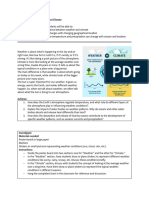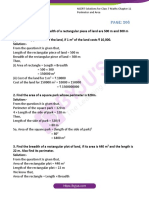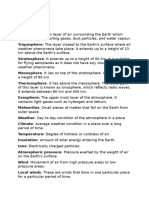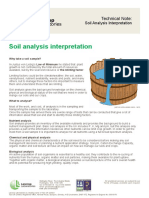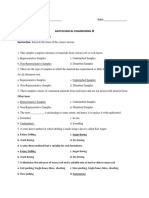Air Class 7
Air Class 7
Uploaded by
Jitendra PatelCopyright:
Available Formats
Air Class 7
Air Class 7
Uploaded by
Jitendra PatelOriginal Description:
Original Title
Copyright
Available Formats
Share this document
Did you find this document useful?
Is this content inappropriate?
Copyright:
Available Formats
Air Class 7
Air Class 7
Uploaded by
Jitendra PatelCopyright:
Available Formats
GEOGRAPHY
CHAPTER: AIR
NOTEBOOK
Ques Write composition of the Atmosphere.
Ans Nitrogen and oxygen are two gases which make up the bulk of the atmosphere. Carbon dioxide,
helium, Argon, Ozone and hydrogen are found in lesser quantities.
Apart from these gases, tiny dust particles are also present in the air.
Nitrogen-
1 It is the most plentiful gas in the air. When we inhale, we take some amount of nitrogen into our lungs
and exhale it.
2 Plants need nitrogen for their survival. They cannot take nitrogen directly from the air. Bacteria, that live
in the soil and roots of some plants, take nitrogen from the air and change its form so that plants can use it.
Oxygen-
It is the second most plentiful gas in the air. Humans and animals take oxygen from the air as they breathe.
Green plants produce oxygen during photosynthesis. In this way oxygen content in the air remains
constant.
Carbon dioxide-
It is another important gas. Green plants use carbon dioxide to make their food and release oxygen.
Humans or animals release carbon dioxide.
The amount of carbon dioxide released by humans or animals seems to be equal to the amount used by
the plants which make a perfect balance.
Ques 2 Write about the structure of the atmosphere.
Ans Our atmosphere is divided into five layers. These are
Troposphere.
Stratosphere
Mesosphere
Thermosphere
Exosphere
1 Troposphere:
-This layer is the most important layer of the atmosphere.
- Its average height is 13 km.
- The air we breathe exists here.
-Almost all the weather phenomena like rainfall. fog and hailstorm occur in this layer.
2 Stratosphere:
-Above the troposphere lies the stratosphere.
- It extends up to a height of 50 km.
-This layer is almost free from clouds and associated weather phenomenon, making conditions most ideal
for flying aeroplanes.
-One important feature of stratosphere is that it contains a layer of ozone gas.
3 Mesosphere:
-This is the third layer of the atmosphere.
-It lies above the stratosphere.
- It extends up to the height of 80 km.
-Meteorites burn up in this layer on entering from the space.
4 Thermosphere:
-In thermosphere temperature rises very rapidly with increasing height.
-Ionosphere is a part of this layer.
- It extends between 80-400 km.
-This layer helps in radio transmission. In fact, radio waves transmitted from the earth are reflected back to
the earth by this layer.
5 Exosphere:
-The upper most layer of the atmosphere is known as exosphere.
-This layer has very thin air. Light gases like helium and hydrogen float into the space from here.
Ques 3 Differentiate between Weather and Climate.
Ans
Weather Climate
1 Weather is the state of atmosphere over a small Climate is the state of atmosphere over a large
area for a short period of time. area for a long period of time.
2 Its elements are temperature, pressure, wind, Its elements are the same but includes aggregate
rainfall, humidity and precipitation. condition over a long period of time.
3 A small changes in any of the elements may lead Small changes over a short period of time does not
to changes in the weather. affect.
Ques 4 Define wind. Explain different types of winds.
Ans The movement of air from high pressure areas to low pressure areas is called wind.
Wind can be broadly divided into three types
1 Permanent Winds: The type of trade winds, westerlies and easterlies are the permanent winds. These
blow constantly throughout the year in a particular direction.
2 Seasonal winds: These winds change their direction in different seasons. Example- Monsoons in India
3 Local Winds: These blow only during a particular period of the day or year in a small area. Example- land
breeze and sea breeze.
Ques 4 What do you meant by Rain? Explain three types of rainfall.
Ans Precipitation that comes down to the earth in liquid form is called rain
1 Convectional Rainfall
This type of rainfall which occur due to thermal convention due to heating of ground surface.
2 Orographic or Relief Rainfall
This is type of rainfall which occur when air has blown over the sea and is then being forced up over an
area of high land.
3 Cyclonic Rainfall
This type of rainfall which occur when warmer air is forced to rise over cold air.
You might also like
- Environmental Impacts of Fast Furniture: Ashleigh MaierDocument13 pagesEnvironmental Impacts of Fast Furniture: Ashleigh Maierapi-399251828No ratings yet
- Machin Dynamic Foundations Xe2ddDocument20 pagesMachin Dynamic Foundations Xe2ddSuresh nathanNo ratings yet
- Water Filtration and PurificationDocument134 pagesWater Filtration and PurificationKhaleel Jaberov100% (2)
- Grade 5 Chapter 8Document6 pagesGrade 5 Chapter 8Ahmar MansoobNo ratings yet
- Class 6 - Maths - AlgebraDocument16 pagesClass 6 - Maths - AlgebraVyan Anand (Admn. No : 7366)No ratings yet
- The First Empire (SM 2) : History Chapter: 8Document3 pagesThe First Empire (SM 2) : History Chapter: 8kundu_mrNo ratings yet
- Class 7 Geography Chapter-2 Inside Our EarthDocument2 pagesClass 7 Geography Chapter-2 Inside Our EarthJapneesh Sidhu100% (1)
- Abu Dhabi Indian School Mathematics Activity Sheet, Std-Viii Rational NumbersDocument2 pagesAbu Dhabi Indian School Mathematics Activity Sheet, Std-Viii Rational NumbersjGBJKgkjdaNo ratings yet
- Udgam School For Children: Subject - Social Science (2021-22) Worksheet No. 12Document3 pagesUdgam School For Children: Subject - Social Science (2021-22) Worksheet No. 12PALAK SHAHNo ratings yet
- Worksheet - Answers - VII - LIGHT (PART 1)Document9 pagesWorksheet - Answers - VII - LIGHT (PART 1)Suvam DasguptaNo ratings yet
- Grade V CH 5 Greenland The Land of Snow (Ques Ans)Document3 pagesGrade V CH 5 Greenland The Land of Snow (Ques Ans)deepak29082023No ratings yet
- Workbook Exercise of Motion and TimeDocument7 pagesWorkbook Exercise of Motion and Timesmi_santhoshNo ratings yet
- Class-7 Integer (Worksheet)Document6 pagesClass-7 Integer (Worksheet)Mayukh ChoudhuryNo ratings yet
- CLASS 5 MATHS - Angles and Triangles Practice QuestionsDocument17 pagesCLASS 5 MATHS - Angles and Triangles Practice Questionsalishbayusuf2022No ratings yet
- CBSE Class 6 Science Components of Food MCQs Set A, Multiple Choice Questions For ScienceDocument4 pagesCBSE Class 6 Science Components of Food MCQs Set A, Multiple Choice Questions For ScienceNinaNo ratings yet
- std.5 - Science Vacation Worksheet - 2023 PDFDocument8 pagesstd.5 - Science Vacation Worksheet - 2023 PDFTheMoneyMitraNo ratings yet
- Class 6 History Chapter 6 Kings Kingdoms Early Republics IDocument5 pagesClass 6 History Chapter 6 Kings Kingdoms Early Republics IThe Vfx CloudNo ratings yet
- Devotional PathsDocument2 pagesDevotional PathsAnmol VIshwakarmaNo ratings yet
- CBSE Class 6 Social Science-Development of First EmpireDocument1 pageCBSE Class 6 Social Science-Development of First EmpireAmitChopraNo ratings yet
- Class 7 - Chapter 14 - Electric Current and Its EffectsDocument4 pagesClass 7 - Chapter 14 - Electric Current and Its EffectshamzaNo ratings yet
- Forests Our Lifeline Notes Class 7Document4 pagesForests Our Lifeline Notes Class 7Ayush BiswasNo ratings yet
- Revision Worksheet - Algebraic Expressions and IdentitiesDocument3 pagesRevision Worksheet - Algebraic Expressions and IdentitiesFatima MishelNo ratings yet
- STD 7 Algebraic Expressions WorksheetDocument2 pagesSTD 7 Algebraic Expressions WorksheetrachnANo ratings yet
- St. Joseph's International School, HisarDocument2 pagesSt. Joseph's International School, HisarRekha KaushikNo ratings yet
- CBSE Class 7 Science Our Environment Chapter 3 Our Changing Earth Important Questions 2024-25Document6 pagesCBSE Class 7 Science Our Environment Chapter 3 Our Changing Earth Important Questions 2024-25shantabhatiNo ratings yet
- Ntse Directions Test-1 WorksheetDocument5 pagesNtse Directions Test-1 WorksheetPREMKUMARNo ratings yet
- Inside Our EarthDocument2 pagesInside Our Earthansh parasharNo ratings yet
- Class7 - Human Environment Interaction - Tropical and SubtropicalDocument3 pagesClass7 - Human Environment Interaction - Tropical and SubtropicalGaurav MalikNo ratings yet
- Motion and TimeDocument13 pagesMotion and TimeRajeevSangam100% (1)
- NCERT Solutions Class 7 Maths Chapter 11 Perimeter and AreaDocument39 pagesNCERT Solutions Class 7 Maths Chapter 11 Perimeter and AreaashaNo ratings yet
- History CH 7 Tribes PDFDocument4 pagesHistory CH 7 Tribes PDFarasu_kavi20038833No ratings yet
- Mensuration: Full Marks-30 Time-40minDocument1 pageMensuration: Full Marks-30 Time-40minwb cs100% (1)
- NCERT Solutions For Class 8 Science Question Chapter 13 ExerciseDocument5 pagesNCERT Solutions For Class 8 Science Question Chapter 13 ExerciseloluNo ratings yet
- CBSE Class 7 Science - Transport and ExcretionDocument1 pageCBSE Class 7 Science - Transport and ExcretionshamshadNo ratings yet
- Reproduction in Animals Class 8 Notes - Chapter 9Document6 pagesReproduction in Animals Class 8 Notes - Chapter 9anushree ranadeNo ratings yet
- 6 SSCDocument2 pages6 SSCsamina shaikhNo ratings yet
- Mahesh Tutorials: (ICSE)Document4 pagesMahesh Tutorials: (ICSE)SanjayNo ratings yet
- Direct and Indirect Speech ExercisesDocument2 pagesDirect and Indirect Speech ExercisessueNo ratings yet
- Cbse Mathematics Question Bank Term Ii Class Vii RoseDocument17 pagesCbse Mathematics Question Bank Term Ii Class Vii RoseDeep ManeNo ratings yet
- Lesson-4 The Deserst Land of India D. I. Very Short Answer QuestionsDocument4 pagesLesson-4 The Deserst Land of India D. I. Very Short Answer QuestionsShiva Kumar RamachandraNo ratings yet
- NCERT Solutions For Class 7 March 31 Science Chapter 7 Weather Climate and Adaptations of Animals To ClimateDocument3 pagesNCERT Solutions For Class 7 March 31 Science Chapter 7 Weather Climate and Adaptations of Animals To Climateramesh selvarajNo ratings yet
- Grade 7-Time and Motion-Class WorkDocument4 pagesGrade 7-Time and Motion-Class WorkaparnamadhuNo ratings yet
- CBSE Class 7 English Conjunctions WorksheetDocument15 pagesCBSE Class 7 English Conjunctions WorksheetSatrajit DasNo ratings yet
- WWW Dronstudy Com Book Crop Production and Management Class 8 NotesDocument13 pagesWWW Dronstudy Com Book Crop Production and Management Class 8 NotesKSP Classes GondiaNo ratings yet
- Class 6 Science Chapter 10 Motion and Measurement of DistancesDocument5 pagesClass 6 Science Chapter 10 Motion and Measurement of Distancessidharth chaturvedyNo ratings yet
- Devotional Path To The DivineDocument7 pagesDevotional Path To The DivinesuvashreeNo ratings yet
- Indus Universal School, Yapral, Secunderabad: Practice Worksheet Grade V Subject: Math Topic: MeasurementDocument1 pageIndus Universal School, Yapral, Secunderabad: Practice Worksheet Grade V Subject: Math Topic: Measurementthejaskaarthik3No ratings yet
- Getting To Know Plants Worksheet 7Document2 pagesGetting To Know Plants Worksheet 7surabhiNo ratings yet
- Class 8 Cbse Science Sample Paper Term 1 Model 2Document4 pagesClass 8 Cbse Science Sample Paper Term 1 Model 2Sunaina RawatNo ratings yet
- Introduction To Graphs Handout & WorksheetDocument6 pagesIntroduction To Graphs Handout & WorksheetAnjishnu TedNo ratings yet
- Microorganism Friend and FoeDocument7 pagesMicroorganism Friend and FoeNEIL GAROONo ratings yet
- Science Chapter - (Reaching The Age of Adolescence) Class 8Document7 pagesScience Chapter - (Reaching The Age of Adolescence) Class 8Khushi Kumari class 9 adm 664No ratings yet
- Coal and Petroleum - Class 8 - NCERT Exercise Questions - PANTOMATHDocument2 pagesCoal and Petroleum - Class 8 - NCERT Exercise Questions - PANTOMATHsourav9823No ratings yet
- CHAPTER-9, Respiration in Organisms.Document3 pagesCHAPTER-9, Respiration in Organisms.HarshitAhelani2379ScribdNo ratings yet
- STD 6 CH 1 Components of FoodDocument7 pagesSTD 6 CH 1 Components of FoodHIRAL SOLANKINo ratings yet
- STD 8 Direct and InverseDocument22 pagesSTD 8 Direct and InverseJet PatnaNo ratings yet
- Major LandformDocument12 pagesMajor LandformMohd. JavedNo ratings yet
- Our Forest Question AnswersDocument5 pagesOur Forest Question AnswersKunal SumukNo ratings yet
- CBSE Class 8 Science WorksheetDocument3 pagesCBSE Class 8 Science WorksheetKULDEEP PALANo ratings yet
- Class 7 Worksheet MathsDocument2 pagesClass 7 Worksheet Mathstoyanath.chamlagain72No ratings yet
- Adarsh Gupta Motion and Time Practice SheetDocument2 pagesAdarsh Gupta Motion and Time Practice SheetAvaniNo ratings yet
- Answer Sheet Grade 7 Properties of TriangleDocument5 pagesAnswer Sheet Grade 7 Properties of TriangleNandini pilaniNo ratings yet
- ch5 SSTDocument9 pagesch5 SSTgoranshkhandelwal38No ratings yet
- Get Environmental Science 16th Edition, (Ebook PDF) Free All ChaptersDocument49 pagesGet Environmental Science 16th Edition, (Ebook PDF) Free All Chaptersbouzitmorote100% (1)
- PublicDocument22 pagesPublicSijabuliso SibandaNo ratings yet
- ECOSYSTEMDocument38 pagesECOSYSTEMbluedB27100% (1)
- Caring For The Environment ScriptDocument6 pagesCaring For The Environment ScriptAlthea Joy SalaanNo ratings yet
- LocalDocument3 pagesLocalTanviNo ratings yet
- Climate CHANGE AssignmentDocument9 pagesClimate CHANGE AssignmentnaseebaNo ratings yet
- Engi̇ne Outter Surface Cleaner Msds (2739)Document10 pagesEngi̇ne Outter Surface Cleaner Msds (2739)Alamana CmeNo ratings yet
- Chao Guo and Kaida ChenDocument7 pagesChao Guo and Kaida ChenSaghar FarajzadehNo ratings yet
- Species Selector Application: Community ForestsDocument55 pagesSpecies Selector Application: Community ForestsEvana NPNo ratings yet
- Lecture 4 Fuels and CombustionDocument54 pagesLecture 4 Fuels and CombustionGuilbert FajardoNo ratings yet
- Thermochemistry: Chemical EnergyDocument24 pagesThermochemistry: Chemical EnergygnpanagiotouNo ratings yet
- Hot Charging DRI HadeedDocument4 pagesHot Charging DRI HadeedAgustine SetiawanNo ratings yet
- Experimental Study On Steel Fibre Reinforced Concrete by Partially Replacement of Cement With GGBS and MetakolinDocument44 pagesExperimental Study On Steel Fibre Reinforced Concrete by Partially Replacement of Cement With GGBS and MetakolinB VAMSI KRISHNANo ratings yet
- Isostasy TheoryDocument4 pagesIsostasy TheoryForman SihombingNo ratings yet
- Chemistry Investigatory Project 2018-19: Setting of CementDocument18 pagesChemistry Investigatory Project 2018-19: Setting of CementHari Krishnan100% (1)
- Problemas Capítulo 37Document26 pagesProblemas Capítulo 37Bryan BritoNo ratings yet
- Ge Sts NotesDocument14 pagesGe Sts NotesMarianNo ratings yet
- Save Our Earth Save Our Rain ForestDocument3 pagesSave Our Earth Save Our Rain ForestgadoNo ratings yet
- Lancrop - Interpreting Soil AnalysisDocument7 pagesLancrop - Interpreting Soil AnalysisHernando MontenegroNo ratings yet
- Reading (Polar Bears)Document1 pageReading (Polar Bears)VSNG EnglishNo ratings yet
- Bct-Module 5Document22 pagesBct-Module 5ValarlaksNo ratings yet
- SolarCraft Hires New Chief Operating Officer - Galen Torneby Will Head Up Operations For North Bay's Leading Solar ProviderDocument2 pagesSolarCraft Hires New Chief Operating Officer - Galen Torneby Will Head Up Operations For North Bay's Leading Solar ProviderPR.comNo ratings yet
- Composite Materials: Unit 1Document2 pagesComposite Materials: Unit 1maheshNo ratings yet
- Chemistry: (Atomic Structure) 1: Subatomic ParticlesDocument6 pagesChemistry: (Atomic Structure) 1: Subatomic Particleskinza atifNo ratings yet
- Recycling/reuse of Plastic Waste As Construction Material For Sustainable Development: A ReviewDocument24 pagesRecycling/reuse of Plastic Waste As Construction Material For Sustainable Development: A ReviewselvakumarNo ratings yet
- 2020-Straub-NREE-Subduction Erosion and Arc VolcanismDocument16 pages2020-Straub-NREE-Subduction Erosion and Arc Volcanismlee BlakeNo ratings yet
- Quiz For Foundation - Answer KeyDocument3 pagesQuiz For Foundation - Answer KeyGie Andal100% (1)



